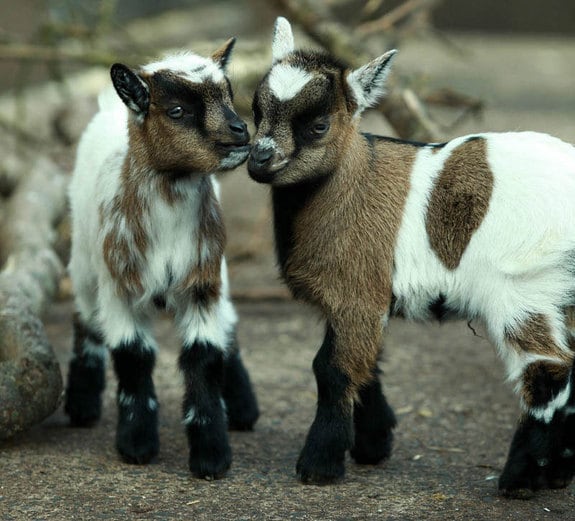Type the name of the breed you're looking for below
[wpdreams_ajaxsearchlite] Don't see the breed your're looking for? Click here and let us know!
Pygmy goat
| Place of Origin | Cameroon |
| Origin | Pygmy Goats were originally called the Cameroon Dwarf Goat since they originated in the former French Cameroon area. They are mostly found in West African countries. Similar forms of Pygmy goats also are found across northern Africa, southern western African countries, and in east Africa. The Cameroon goats were exported from Africa to zoos in Sweden and Germany where they were on display as exotic animals. The first Pygmys probably arrived in the United States in 1959 from Sweden. A pygmy goat is a breed of miniature domestic goat. Pygmy goats tend to be kept as pets primarily, though also work well as milk producers and working animals. The pygmy goat is quite hardy, an asset in a wide variety of settings, and can adapt to virtually all climates. |
| Purpose | Milk, Pet |
| Characteristics | Females, called does, weigh 24 to 34 kg (53 to 75 lb) and males, called bucks, weigh 27 to 39 kg (60 to 86 lb). Wither height ranges from 41 to 58 cm (16 to 23 in). The colour and pattern of their coats vary significantly, and can be categorized into caramel patterned, agouti patterned, and black patterned. Within these categories, there are caramel with black markings, caramel with brown markings, brown agouti, grey agouti, black agouti, black with white markings, and solid black. Pygmy goats are precocial and polyestrous breeders; bearing one to four young every nine to 12 months after a five-month gestation period. Does are usually bred for the first time at about twelve to 18 months, although they may conceive as early as two months if care is not taken to separate them early from male kids. Newborn kids will nurse almost immediately, begin eating grain and roughage within a week, and are weaned by ten weeks of age. Polyestrous sexual behavior means that they experience heat and can be freshened (made to come into milk production) year-round. If milking is a priority, a continuous supply of milk can be obtained by breeding two or more pygmy does alternately. Some full-size dairy breeds are also noted for polyestrous sexual behavior. Scientific name: Capra aegagrus hircus Average lifespan: 8–18 years Normal body temperature: 101.5-104 °F (39.1 - 40 °C) Normal pulse rate: 60-90 beats per minute (faster for kids) Normal respiration rate: 15-30 per minute Rumen movement: 1-1.5 per minute Gestation period: 145–155 days (average 150 days) Heat (oestrus) cycle: 18–24 days (average 21 days) Length of heat: 12–48 hours (average 1 day) Weaning age (recommended): 8–10 weeks Males sexually mature: 9–12 weeks Females onset of heat: 3–12 months Dehorning (by veterinary surgeon): By 7 days Castration: Using elastrator ring: by 2 weeks |
| Other Considerations | Housing and care: Pygmy goats are adaptable to most climates. Their primary diet consists of greens and grains. They enjoy having items to jump on and may be able to leap onto small vehicles. They are also in need of a shed and open area accessible at all times. They also need a companion, which doesn't necessarily have to be its own species. They are prey animals and should therefore be sheltered in a predator-proof area -especially at night. Goats require fresh water at all times or they won't drink it. Pygmy goats are often affectionate if they are treated with respect. They can also be trained, though it requires quite a bit of work. It is important to make sure pygmy goats are comfortable and warm during the winter months. Simple measures such as feeding pygmy goats lukewarm water and lukewarm food, as well as ensuring their living quarters are free from drafts, can make pygmy goats a lot happier during the winter. |



